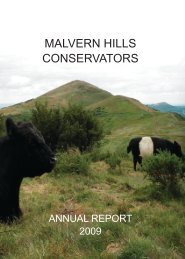Footpath degradation of the Malvern Hills - Malvern Hills Conservators
Footpath degradation of the Malvern Hills - Malvern Hills Conservators
Footpath degradation of the Malvern Hills - Malvern Hills Conservators
You also want an ePaper? Increase the reach of your titles
YUMPU automatically turns print PDFs into web optimized ePapers that Google loves.
Stephen Britnell<br />
<strong>Footpath</strong> <strong>degradation</strong> <strong>of</strong> <strong>the</strong> <strong>Malvern</strong> <strong>Hills</strong><br />
overall <strong>the</strong> relationship is moderately strong and agrees with previous studies. Slope angle is<br />
a reasonably strong controlling variable acting over footpath morphology.<br />
5.2.3 Slope angle and erosional processes<br />
Slope angle is a controlling variable over <strong>the</strong> distribution <strong>of</strong> erosional features <strong>of</strong><br />
braiding, gullying, and pigeon holing (See Figure 14). Braiding does not occur on slopes<br />
above 15degrees. This may be because a significant controlling factor affecting braiding <strong>of</strong><br />
footpaths is user behaviour. People tend to diverge from <strong>the</strong> main path because it is beneficial<br />
to walk somewhere else. From observations in <strong>the</strong> field it can be said that people tended to<br />
diverge to get a better view <strong>of</strong> <strong>the</strong> surrounding scenery and to avoid eroded paths that are<br />
uncomfortable to walk upon. On flatter slopes divergence <strong>of</strong> walkers is more prevalent<br />
because it is easier to do, resulting in a concentration <strong>of</strong> braiding on path sections with low<br />
slope angles.<br />
Gullys are generally signs <strong>of</strong> serious erosion, and I expected to find <strong>the</strong>se on <strong>the</strong><br />
steepest slopes, although results show that gullys form generally on mid-slopes ranging from<br />
6to 20degrees. However, Leopold et al. (1964) states that <strong>the</strong> main controlling factor on gully<br />
erosion is <strong>the</strong> enlargement <strong>of</strong> depressions by <strong>the</strong> action <strong>of</strong> water. This is why my initial <strong>the</strong>ory<br />
based solely on slope angle is floored. The action <strong>of</strong> water flowing across <strong>the</strong> paths is not<br />
looked at in this study due to fieldwork being carried out during <strong>the</strong> summer. Gullys are found<br />
primarily on steeper mid-slopes <strong>of</strong> angles between 16 and 20degrees, suggesting that gully<br />
formation is controlled by slope angle to a certain extent. Possibly by <strong>the</strong> fact that with a rise<br />
in slope angle water action, in <strong>the</strong> form <strong>of</strong> run-<strong>of</strong>f becomes greater in volume and velocity, and<br />
so more erosive.<br />
Pigeonholes clearly form on <strong>the</strong> steepest slopes, and are not found on lopes below<br />
11degrees. This may be due to recreational pressure. As people walk up steep slopes <strong>the</strong><br />
erosive action <strong>of</strong> <strong>the</strong>ir feet increases (Deluca et al. 1998). This may be <strong>the</strong> cause <strong>of</strong><br />
pigeonholes, which once form act like steps up <strong>the</strong> slope, and are repeatedly trampled on and<br />
41





